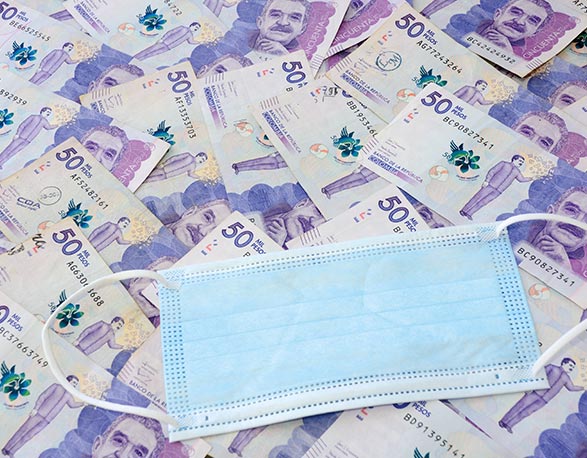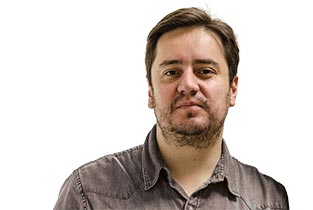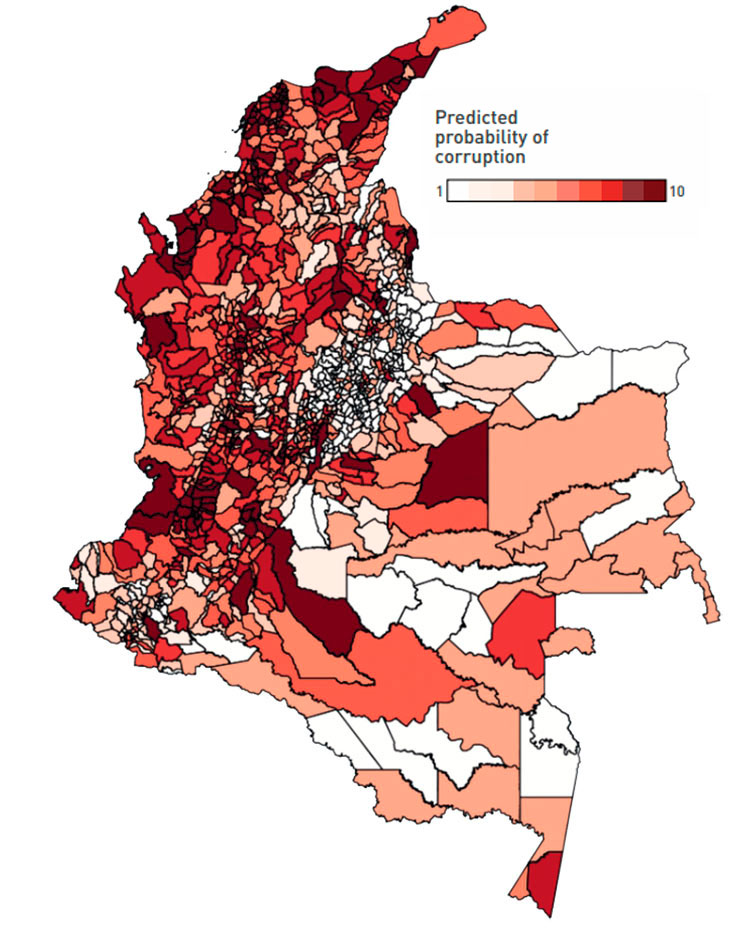COVID-19, ‘an opportunity for corruption’
By: Mauricio Veloza
Photos:
Economics and Politics

By: Mauricio Veloza
Photos:
Word wide, there is no doubt that corrup - tion represents a “monster with a thousand heads,” and it may be a worse disease than COVID-19. What is also true is that, in Co - lombia, it has acquired disproportionate di - mensions after the national government de - clared a sanitary emergency in March 2020.
The study, “Corruption in Pandemic Times” clearly demonstrates the association between local councils that are prone to corruption and an increase in the execution of higher value and direct contracts during the pandemic. In other words, this shows that in some areas of the country, the sanitary crisis posed an opportunity for the authorities to get benefit by taking advantage of their power to the detriment of collective interest.
The main story behind this article is that, with the arrival of the pandemic in Colombia, the governments had to allocate large amounts of money and increase their public spending, in a short period, to meet the needs caused by the sanitary emergency. We argue that when these events occur, there is a window for corruption because some public recruitment practices become irregular,” claims Jorge Gallego, a professor at the Faculty of Economics in Universidad del Rosario and one of the main researchers.
Mounu Prem and Juan Fernando Vargas, members of the same Faculty, complete the researching group that highlights the importance of being flexible to conveniently address the crisis. In the case of Colombia, however, this has become too risky due to the increase in irregularities and inefficiencies in relation to public procurement and recruitment .
To reach their conclusions, the researchers employed a novel methodology that combines theory and technology. In this case, they measured corruption, understood as the appropriation of public resources to satisfy private interests, from available objective data, not from perceptions or surveys as it had traditionally been done.
Furthermore, they started their work under the assumption that corruption obeys to structural conditions and not only to the idiosyncratic causes of governments, which generally prevail. Thus, they built an indicator to establish how prone to corruption can these regions be
“The statistical model shows which structural characteristics within each local council best predict the observed corruption. There are some cases, however, in which these characteristics are not present but there are still some corruption events. This occurs because the model makes predictions for the average city council, not for particular cases,” clarifies Professor Prem in an interview with the portal La Silla Académica, published on May 22, 2020.
According to this postulate, they characterized 1100 city councils in the country that had enough information for the 147 variables that defined them (child mortality, Saber scores, population size, urban/rural, and the presence of armed groups, among others). Then, they characterized them into 10 groups: financial sector, conflict, crime, human capital, local politics, public sector, local demography, economic activity, illegal activity, and natural resources. The analyzed periods were 2008–2011 and 2012–2015.
The defined data were then compared with other indicators: the mayors that, during those periods, had faced or not some disciplinary process in the Attorney General’s Office for alleged corruption, based on an investigation on governmental performances and the sources of income conducted by professor Luis Martínez of the University of Chicago.

"This tool gives us a guideline to observe which areas are prone to corruption, but it is not a one hundred percent probability. What we can observe is that there is a large connection between our corruption index and the fact that entities such as the National Audit Office can detect irregularities in contracts signed to respond to the emergency caused by the arrival of COVID-19 in Colombia,” explains Jorge Gallego, professor at the faculty of Economics.
The researchers could identify three sets of variables that may better predict a larger risk of corruption in the average city councils:
Artificial Intelligence in the Service of Investigation
To build the model, the researchers established all possible correlations between structural conditions and the presence or absence of open processes for alleged corruption, achieving a predictor accuracy of 70 percent. The obtained results were compared to the data received from the Attorney General’s Office about ongoing investigations by local authorities to check whether the model was effective.
We basically used AI tools, particularly related to machine learning, that were fed with information about activities conducted by municipal authorities, and we compared them to the observable characteristics of the city councils in different dimensions. Later, we trained the algorithms to estimate the probability of possible corruption events in a particular city council during 2020,” explains Gallego, who is the director of the TIC-Tank Center at Universidad del Rosario.
The investigation shows, among other interesting facts, that food contracts increased the most: 13 percent from March 6 (the date of the first reported COVID-19 case in the country) and up to 21 percent after the sanitary emergency decree, announced on March 12, 2020. Moreover, this occurred in the city councils that were prone to corruption.
“One possible explanation could be that when it comes to food, it is easier to get it and increase its price; however, the chains of production and commercialization of health equipment are much more limited,” notes Prem.
The professors highlight that Colombia could counteract these situations if there were a municipal corruption indicator. Thus, they decided to create a corruption map in which they ranked each municipality with a high or low corruption risk on a one-to-ten scale. The georeferencing demonstrates that there is practically no region without corruption. Statistically, it is a common problem in all regions.
An interesting point about the model is that the private and financial sectors play a very important role when explaining the existence of corruption,” assures Professor Gallego. “These aspects are not usually considered by the studies that target the public sector and politicians. Corruption acts in public procurement always involve a private party. This is what we call the structural causes of corruption,” he adds.
The group of experts analyzed a total of 360,000 contracts for the amount of 17 billion pesos, which the city councils had uploaded to the platforms Secop I and Secop II from January to April 27, 2020. Secop is a tool for the public procurement of the Colombian State.
Thus, the researchers found that in the city councils with a higher corruption risk, the possibility to sign direct contracts increased by 7 percent between March 6 and April 27. “Eliminating the competition among offers and reducing the time to present and debate proposals makes it easier to choose friends or pay favors with contracts. This also generates extra charges,” explains Professor Prem.
Likewise, the research team discovered that, from March 17, 2020, the city councils with a high corruption risk increased using direct contracts by 8 percent and their average value by 11 percent in comparison to the city councils less prone to corruption.
This information agrees with the fact that after such a date, Colombia Compra Eficiente, the agency in charge of coordinating public recruitment, announced that local governments could appeal to the emergency to adapt their recruitment procedures as needed.
This tool gives us a guideline to observe which areas are prone to corruption, but it is not a one hundred percent probability. What we can observe is that there is a large connection between our corruption index and the fact that entities such as the National Audit Office can detect irregularities in contracts signed to respond to the emergency caused by the arrival of COVID-19 in Colombia,” explains Gallego
A National Pandemic
With all this information, the researchers truly believe that corruption is not restricted to COVID-19 or epidemics; instead, when catastrophic events such as wars, financial crisis, or natural disasters occur, governments have to spend considerably in a short period. Therefore, public procurement norms get irregular, clearing the way for corruption.
“In relation to COVID-19, the regulation states that direct recruitment must be an exception. It can only take place in very particular cases, when there is a clear emergency. That is what the mayors did: declare an emergency and sign “atrandom contracts” with friends or campaign financiers. This is how you increase expenditure; however, simultaneously, you increase the risk of corruption,” explains Gallego
Moreover, although it may seem that this phenomenon is more frequent in small places, the researchers informed us otherwise. “In places where you think that corruption is being handled, the risks are higher. The big cities in the country usually have high corruption rates because they manage expensive longterm contracts. The larger a project, the higher the risk of corruption,” states Gallego.
In his opinion, corruption is closely related to institutionalization, to formal and informal norms, and to the way in which the political system works in Colombia, where campaigns are basically investments, and the politicians once elected must “pay” those who invested in their campaign through contracts or public service positions.
The words of Carlos Gaviria (RIP), a well-known magistrate of the Constitutional Court and college teacher, “Those who pay to get there, get there to steal” clearly summarize the way in which politics function in Colombia. “I believe that a political system such as the Colombian, characterized by favoring, the purchase of votes, interest groups, and patronage, is a system that perpetuates corruption,” he declare
Key Audits
With these results, Professors Vargas, Prem, and Gallego are trying to get the attention of control organisms to reinforce the stages of monitoring and audit.
In fact, the National Audit Office has a Scientific Data Department where engineers, mathematicians, economists, and computing experts compare the prices of the national government and local councils contracts (registered in Secop) against market prices in real time. With these tools, the National Audit Office has issued alerts and warned the city councilis
“They have managed to complete a real-time audit on thousands of contracts, but if governments co-opt the control agencies, then there is not much to do. Society and the media will have to act as controllers to avoid corrupt acts,” claims Gallego
Although this investigation only analyzed the data registered at the beginning of 2020, the researchers believe that one year after the pandemic it would be worth reflecting upon public recruitment matters. Particularly, there should be a study on the impact of the common front between the District Attorney, Public Prosecutor, and National Audit Office. Likewise, it would be important to revise the regulations on the program “Colombia Compra Eficiente.”
Preventing corruption may save lives,” he concluded forcefully.
A new research methodology
The tools of data science, to measure, quantify, and seek solutions, are used in the research “Corruption in Pandemic Times,” which is a line of research that the TIC-Tank Center of the Universidad del Rosario has been promoting. This group of experts is led by Professor Jorge Gallego, who is also an economist and has a PhD in Political Science from New York University
“Corruption in Pandemic Times” is in the process of being published in an international scientific journal, and the research group was invited to write a chapter in a book on the subject edited by the World Bank. Moreover, the group, combined with the Applied Mathematics and Computer Science program, has a project for the District Inspection Office financed by the Development Bank of Latin America (CAF). The objective is to design and implement an early warning system that will allow the entity to anticipate which contracts have a higher risk of irregularities and inefficiency and, in this way, better control the resources in Bogota.
Colombia: surrounded by corruption
